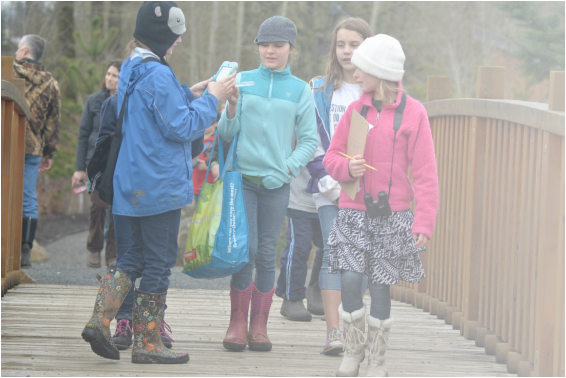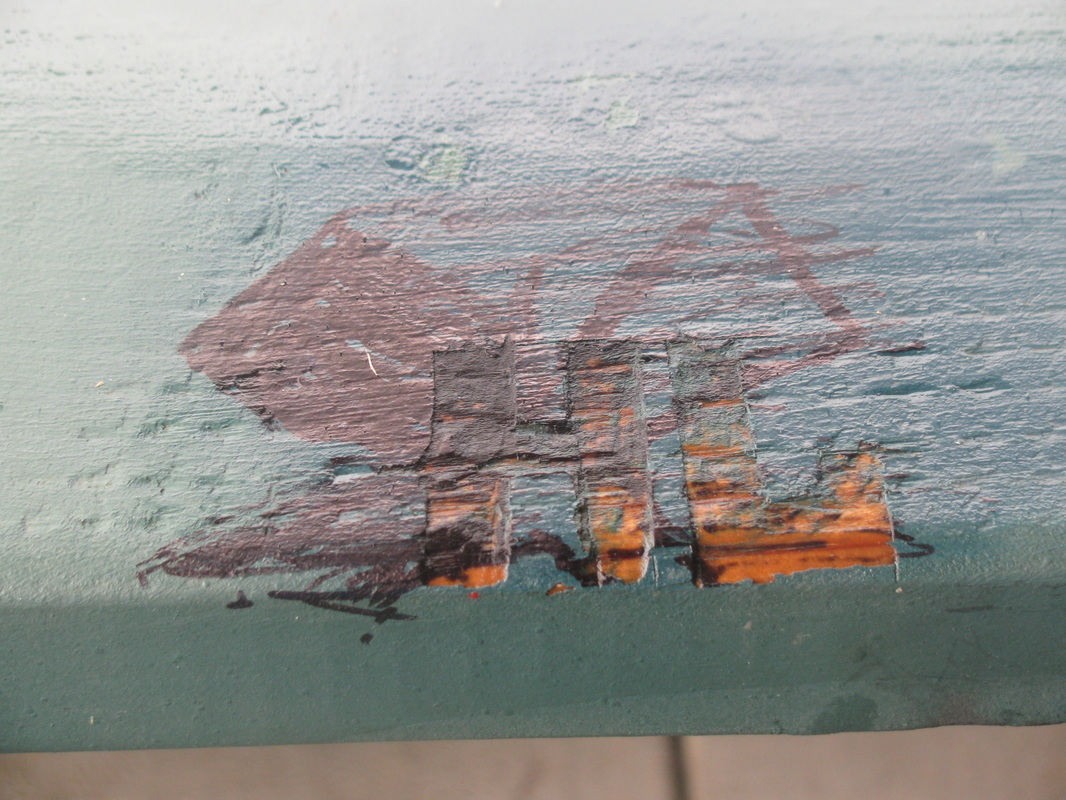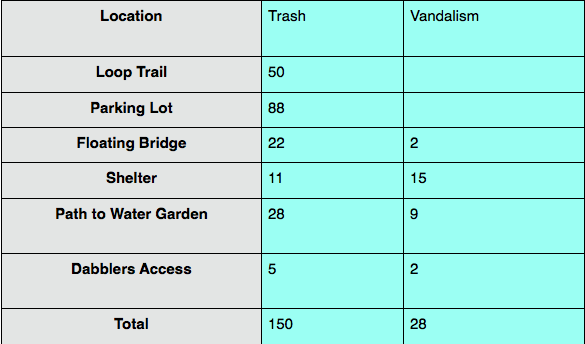The Human Footprint

Question: What kind of human impact, like litter, vandalism, or ecological damage, can be found at Fernhill?
Hypothesis: We think we won't find too much trash and vandalism, but we will find some.
Hypothesis: We think we won't find too much trash and vandalism, but we will find some.
|
This is a picture of some vandalism we found in the Shelter.
|
Introduction
You walk into the wetlands. The sun shimmers on the blue wavy water. The birds sing. Then, you see a piece of trash. Fernhill wetlands is home to many animals and because of that it attracts many people. But we want to find out if that is good or not. We're the Human Impact group for the Kestrel class, and our team wants to find out how much of an impact humans have on Fernhill. By human impact, we mean any trash found outside a trash can or vandalism. Examples of vandalism are drawings on the rocks, benches, trees, or any surface. Our research measured this type of impact at Fernhill. |
Methods: We walked around the trails and the parking lot to look for trash and vandalism. When we found trash we would pick it up and put it into a bag we carried around and recorded it. If we found any instances of vandalism we took a picture and recorded it. If we ran into any groups we would interview them about their work in their groups. The very last time we went around the loop trail, because it was open for the first time that year!
Please note that the total for trash is incorrect, it is supposed to be 176
Findings: This table shows how much trash was found in all three months. The place with the
most trash was the parking lot, and the place with the most vandalism was the shelter. Even though
the loop trail was closed the first two times we went, when we went in May it had a lot of trash.
Overall this data shows that they should probably put trash cans around the trails.
Conclusion:
Our hypothesis was partially incorrect, there was too much litter but there wasn’t that much vandalism. This shows that people care more about permeant damage and the scenery of Fernhill more than the interment damage. Also maybe the people who work for Fernhill should add trashcans near/at the gazebos and along the loop trail, that’s where the majority of the trash was. As the reconstruction is getting finished either people are coming more so there naturally more vandalism or the visitors are becoming more careless about where their litter go. Why do we think this? Well as I said before, the litter is increasing by a big amount. Although we could have miss marked and counted the amount of trash and vandalism. I know for a fact that we missed some litter for sure, so our data might be a tinny bit off, but still correct. We would like to know whether people will use the trash cans if they're installed and why people even litter and/or vandalize.
Reflection:
Looking at the human impact at Fernhill Wastelands was fun, interesting and challenging at the same time. We enjoyed walking around Fernhill and the magnificent view. Also, we enjoyed interviewing groups and seeing what they were doing.
It was really hard to see the trash on the ground and everywhere else. We learned to be more observant and careful. Those skills are important for finding little pieces of trash, and in everyday life. I hope that we can continue to go to Fernhill because it will be interesting to see what else we find.
Findings: This table shows how much trash was found in all three months. The place with the
most trash was the parking lot, and the place with the most vandalism was the shelter. Even though
the loop trail was closed the first two times we went, when we went in May it had a lot of trash.
Overall this data shows that they should probably put trash cans around the trails.
Conclusion:
Our hypothesis was partially incorrect, there was too much litter but there wasn’t that much vandalism. This shows that people care more about permeant damage and the scenery of Fernhill more than the interment damage. Also maybe the people who work for Fernhill should add trashcans near/at the gazebos and along the loop trail, that’s where the majority of the trash was. As the reconstruction is getting finished either people are coming more so there naturally more vandalism or the visitors are becoming more careless about where their litter go. Why do we think this? Well as I said before, the litter is increasing by a big amount. Although we could have miss marked and counted the amount of trash and vandalism. I know for a fact that we missed some litter for sure, so our data might be a tinny bit off, but still correct. We would like to know whether people will use the trash cans if they're installed and why people even litter and/or vandalize.
Reflection:
Looking at the human impact at Fernhill Wastelands was fun, interesting and challenging at the same time. We enjoyed walking around Fernhill and the magnificent view. Also, we enjoyed interviewing groups and seeing what they were doing.
It was really hard to see the trash on the ground and everywhere else. We learned to be more observant and careful. Those skills are important for finding little pieces of trash, and in everyday life. I hope that we can continue to go to Fernhill because it will be interesting to see what else we find.


